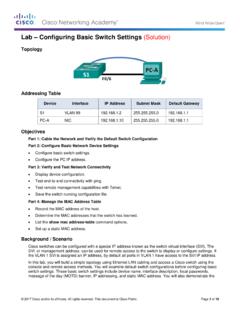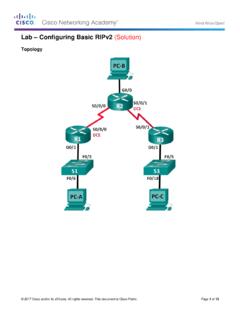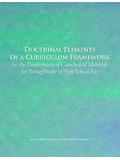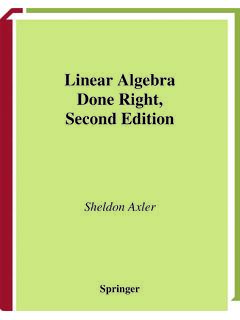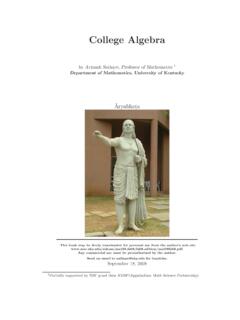Transcription of Parallel Lines Cut by a Transversal - Radford
1 Parallel Lines Cut by a Transversal I. UNIT OVERVIEW & PURPOSE: The goal of this unit is for students to understand the angle theorems related to Parallel Lines . This is important not only for the mathematics course, but also in connection to the real world as Parallel Lines are used in designing buildings, airport runways, roads, railroad tracks, bridges, and so much more. Students will work cooperatively in groups to apply the angle theorems to prove Lines Parallel , to practice geometric proof and discover the connections to other topics including relationships with triangles and geometric constructions. II. UNIT AUTHOR: Darlene Walstrum Patrick Henry High School Roanoke City Public Schools III.
2 COURSE: Mathematical Modeling: Capstone Course IV. CONTENT STRAND: Geometry V. OBJECTIVES: 1. Using prior knowledge of the properties of Parallel Lines , students will identify and use angles formed by two Parallel Lines and a Transversal . These will include alternate interior angles, alternate exterior angles, vertical angles, corresponding angles, same side interior angles, same side exterior angles, and linear pairs. 2. Using the properties of these angles, students will determine whether two Lines are Parallel . 3. Students will verify parallelism using both algebraic and coordinate methods. 4. Students will practice geometric proof . 5. Students will use constructions to model knowledge of Parallel Lines cut by a Transversal .
3 These will include the following constructions: Parallel Lines , perpendicular bisector, and equilateral triangle. 6. Students will work cooperatively in groups of 2 or 3. VI. MATHEMATICS PERFORMANCE EXPECTATION(s): The student will use the relationships between angles formed by two Lines cut by a Transversal to a) determine whether two Lines are Parallel ; b) verify the parallelism, using algebraic and coordinate methods as well as deductive proofs; and c) solve real-world problems involving angles formed when Parallel Lines are cut by a Transversal . VII. CONTENT: Students will use prior knowledge of Parallel Lines cut by a Transversal and geometric constructions to create a map to given specifications.
4 The map will be a representation of a small section of a city or town and will serve to introduce students to the usefulness of mathematics in a different context. This project will encourage students to work cooperatively and to see how these concepts are used in the real world. VIII. REFERENCE/RESOURCE MATERIALS: SMART Board, document camera, or LCD projector for modeling, markers, calculators, rulers, compasses, poster boards, and the following handouts: Pre-Assessment (Attached) Construction worksheets (Attached) Lesson 2 homework (Attached) Directions for map construction (Attached) Solution for map construction (Attached) IX. PRIMARY ASSESSMENT STRATEGIES: Attached for each lesson.
5 Students will be given a pre-assessment in the form of a handout to assess prior knowledge at the beginning of the unit. The teacher will observe students as they work on tasks to see if and where any additional help may be needed. Teacher will also monitor, observe, and communicate with students as they work in groups. homework assignments will be given after each lesson. The homework will be discussed with the class and graded by the instructor. The final assessment will be the completed project. X. EVALUATION CRITERIA: Attached for each lesson. Students will be observed as they work during class. Whole class discussions will also help the instructor to determine student knowledge.
6 Students will check each others work throughout the unit. Presentations by the students and feedback from their peers will also serve as an evaluation tool. The final assessment will consist of the construction of a map and problems regarding Parallel Lines from the map. XI. INSTRUCTIONAL TIME: The unit should take a total of three days of block scheduling, six days if standard. LESSON 1: Parallel Lines & CONSTRUCTIONS STRAND: Geometry MATHEMATICAL OBJECTIVES: To review and practice geometric constructions. To review and practice concepts regarding Parallel Lines cut by a Transversal . To determine whether two Lines are Parallel .
7 To encourage working cooperatively in small groups. Recognize properties of Parallel Lines outside of the classroom. MATHEMATICS PERFORMANCE EXPECTATIONS: MPE The student will use the relationships between angles formed by two Lines cut by a Transversal to determine whether two Lines are Parallel . VIRGINIA SOL: , c, f, g The student will use the relationships between angles formed by two Lines cut by a Transversal to determine whether two Lines are Parallel . The student will construct and justify the constructions of: A perpendicular to a given line from a point not on the line . An angle congruent to a given angle. A line Parallel to a given line through a point not on the given line .
8 NCTM STANDARDS: Use geometric models to gain insights into, and answer questions in, other areas of mathematics. Use geometric ideas to solve problems in, and gain insights into, other disciplines and other areas of interest such as art and architecture. Explore relationships among classes of two-dimensional geometric objects, make and test conjectures about them, and solve problems involving them. Draw and construct representations of two- and three-dimensional geometric objects using a variety of tools. MATERIALS/RESOURCES: Classroom set of calculators, SMART Board or document camera to model constructions for students, rulers, compasses, and the following handouts: pre-assessment, and construction guides.
9 ASSUMPTION OF PRIOR KNOWLEDGE: The student should have already completed the Geometry course offered at his/her school. Students should understand the concepts and properties of Parallel Lines cut by a Transversal . Students should be able to accurately construct a pair of Parallel Lines , a perpendicular bisector and an equilateral triangle. Students may have difficulty recalling vocabulary. LESSON OUTLINE: I. Introduction: Review Parallel Lines cut by a Transversal . (20 30 minutes) A. Explain to the class they will be working on a project involving Parallel Lines cut by a Transversal and their related angles. B. Ask students to sketch a pair of Parallel Lines cut with a Transversal on a piece of paper at their desks.
10 The instructor should sketch the same figure on the dry erase board at the front of the class or using a document camera. Have students mark the angles 1 8. C. Review the following vocabulary terms encouraging students to offer their own definitions: (Note: do not give these definitions until after you have discussed the students definitions). 1. Parallel Lines coplanar Lines that do not intersect 2. Transversal A line that intersects two or more coplanar Lines 3. Alternate Interior Angles Two nonadjacent interior angles on opposite sides of a Transversal 4. Alternate Exterior Angles Two nonadjacent exterior angles on opposite sides of a Transversal 5.


